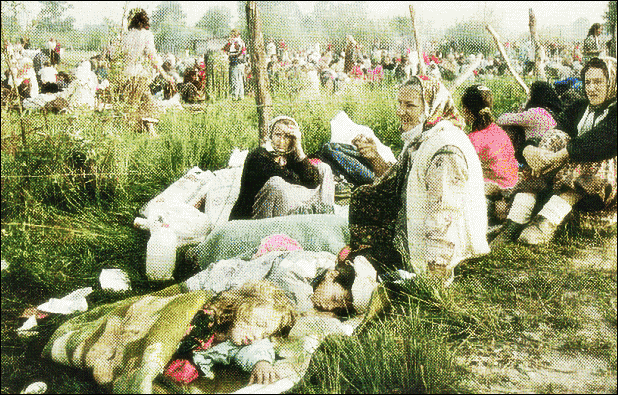Time won't heal
Dato'Dzulkifli Abd Razak
Article
New Sunday Times - 07/10/2005
 BOSNIAN TRAGEDY: Refugees from Srebrenica outside the UN base at Tuzla airport in July - AP file picture
BOSNIAN TRAGEDY: Refugees from Srebrenica outside the UN base at Tuzla airport in July - AP file picture
TEN years ago, a group of Serb paramilitary soldiers, dubbed the "Scorpions", shocked the world when they butchered Bosnians at Srebrenica, in eastern Bosnia.
Early last month, the world was again shocked when video recording of that chilling tragedy in July 1995 was released.
Described by the media as "sickening", it showed a "brutal, callous and disgraceful crime against civilians", to use the words of the Serbian Prime Minister.
On his orders, eight suspects were arrested.
The video was made available during the war trial of the former Serbian strongman, Slobodan Milosevic, in The Hague.
It was the first graphic material on the massacre unearthed by a Serbian human rights organisation.
It was a rude awakening for the majority of Serbs who until now refuse to acknowledge that the tragedy even took place, according to a recent public opinion poll.
Serbia has always denied any involvement in the 1992-1995 Bosnian war, which saw Serbs fighting against Bosnians, who broke off from the former Yugoslavia, and against Muslims and Croats who backed the Bosnians.
The war claimed about 260,000 lives and left about 20,000 missing and presumed dead.
Srebrenica was then a United Nations-designated so-called "safe area" placed under the custody of a few hundred lightly armed Dutch forces.
Bosnian Serb troops brushed aside the Dutch forces and the 30,000 people seeking refuge in the town faced genocide.
The rapid fall of Srebrenica has raised a number of numbing questions and allegations, including possible secret deals.
At least two Bosnian families who survived the 1995 massacre have started legal proceedings' in the Dutch courts.
The recording reportedly showed one specific episode of six of young men taken out of a truck with then-hands tied behind their backs and led to a clearing where at least three of them were taunted and then shot at close range.
The video begins with a Serb priest blessing the camouflaged paramilitary troops in a boot camp in Bosnia before they went on a rampage.
It ends with what appears to be the same paramilitary troops shooting badly beaten civilian prisoners in the back with machine guns.
Some of their faces were in fact clearly identifiable.
The video, said to have been shot by the paramilitary group, provided clear evidence that members of the "Scorpion" groups were involved.
The "Scorpions", based on an interview with a UN war crime prosecutor, were placed under the command of the Serbian police and transferred to Bosnia with police knowledge to join the fighting.
But this is not all. A Serbian television station claimed that the footage of the other youths taken to a house and tortured before they were killed was "too disturbing" to be broadcast.
Indeed, there are thousands of others who shared a similar tragic fate, including many women and children who were tortured, raped and killed.
The Bosnian Serb commander, Ratko Mladic, is one of the prime suspects in the massacre, together with his notorious superior, Radovan Karadzic.
Both are still at large.
Despite the UN war crimes court's demand for their arrest, there are still no signs that they would be captured any time soon.
But as the Prime Minister of Serbia was quoted as saying, "it is important for our public that we reacted immediately".
Like the Serbian leaders who have been arrested, tried and convicted in The Hague tribunal, it is only a matter of time before justice catches up with the rest.
Similarly, the Serbian President asserted through a nationally televised message, in conjunction with the release of the video, that "those seen in these pictures committing murder were free men until yesterday. They were walking our streets — they must face justice".
The Serbian leader, while admitting to the "monstrous" nature of the crime committed in Serbia's name, has also indicated his readiness to go to Srebrenica for the 10th anniversary of the massacre.
But this may not be enough, as in the case of the Japanese war atrocities.
Recently, people in China and South Korea staged violent protests against new Japanese textbooks which allegedly glossed over the brutalities that the Japanese troops committed during the Second World War.
Japan is accused of militarism and aggression carried out in the region some 60 years ago.
Apparently, time has not healed the wounds that still remain all too raw, even after the Japanese Prime Minister had apologised in what is regarded as the most public apology yet.
At the recent Asia-Africa Summit in Jakarta he confessed that "Japan squarely faces these facts of history in a spirit of humility".
"And with feelings of deep remorse and heartfelt apology always engraved in mind, Japan has resolutely maintained consistently since the end of World War II, never turning into a military power but an economic power."
For victims of Srebrenica too, it should be no different.
In no uncertain terms, the perpetrators and their representative governments must publicly admit and apologise for their heinous atrocities.
It was the worst post-World War II massacre in Europe involving a different religious-ethnic group.
It was an act of ethnic cleansing where about 8,000 Muslim men and boys were killed from July 12 through July 18 in and around Srebrenica.
So far more than 30 mass graves associated with the killing have been traced.
The war victims of all villages, cities and nations whose people were bloodied by despicable crimes against humanity deserve similar apologies and attention.
For too long, many have been conveniently relegated to the dustbin of history, especially those forcibly colonised and hegemonised.
And like Milosevic and his bloodthirsty commanders, those responsible too must be brought to justice.
Recommended sites: http://www.spartaus.schoolnet.co.uk/FWWatrocities.htm
